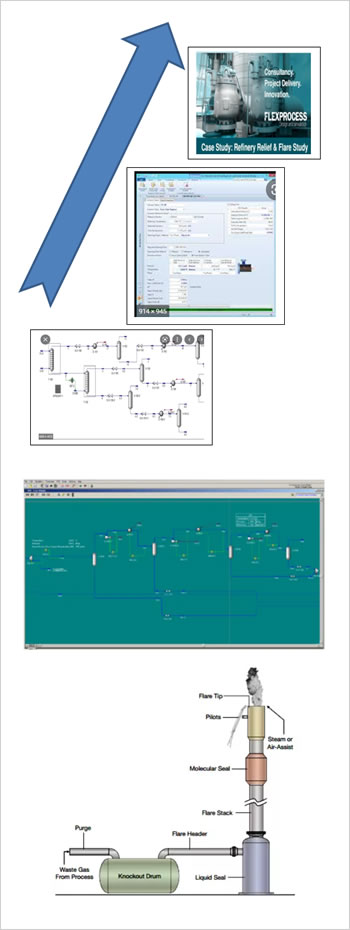Relief system design and analysis
 A well designed relief system may protect the equipment, process system and the operating plant during any catastrophic event. However, it is essential to have proper experience and knowledge to design an adequate relief system.
A well designed relief system may protect the equipment, process system and the operating plant during any catastrophic event. However, it is essential to have proper experience and knowledge to design an adequate relief system.
Engimates team members previous work experiences possess excellent knowledge of ANSI/API/ISO standards, Client design engineering practices, Specific refinery guidelines and expertise in using PSPPM, Aspentech Safety Analysis, and spreadsheets tools. This brings uniqueness to EngiMates relief system design and analysis services.
We provide following services for Relief System (PSV) Analysis:
- Process simulation modeling at normal operating plant conditions and relief conditions for fractionators / column system, heat exchangers, compressors, turbines, vessels etc. in Aspentech HYSYS, Aspen Plus and Honeywell UNISIM.
- Adequacy check of refinery relief & flare systems based on the refinery specific guidelines, OSHA, API-520/521/2000 standards using client proprietary software or EngiMates validated Excel Spreadsheet Tools.
- Data collection
- Define the system/equipment to be protected
- Input Equipment/system and Relief Device information
- Define all overpressure scenarios
- Calculate relief rate for applicable scenarios
- Size relief device for all applicable scenarios
- Complete commenting forms and discussion list.
- Develop mitigation options for inadequate relief devices, high inlet & outlet pressure drop concerns and other concerns.
- Developed project report / discussion list for the concerns identified & their mitigations.
We provide following services for Flare and Blowdown Study:
- Assessment of the spill to flare valves
- Identification of the governing scenario for every spill-to-flare valve in the plant and calculation of the minimum fluid and material temperature in the flare system.
- Calculation of the minimum temperature for scenarios such as normal operation, start-up, cold restart, hydrate formation etc.
- Assessment of the blowdown systems
- Identification of the blowdown scenarios (fire ESD, adiabatic and maintenance blowdown) for every blowdown valve in the plant and calculation of the minimum fluid and material temperature in the flare system.
- Calculation of the minimum temperature for scenarios such as normal operation, start-up, cold restart, maintenance blowdown, hydrate formation etc.
- Confirmation blowdown system meets relevant depressurizing criteria.
- Confirmation that the material is adequate for the low temperatures.
- Flare Adequacy Study
- Develop Flarenet model of exiting plant in Aspen Flare System Analyzer.
- Identify governing scenarios for HP Flare and maximum loads.
- Perform adequacy study on all parts of the Flare System, including sub-headers, headers, Flare Knock-Out Vessel, flare stack and Flare tip
© Engi Mates 2017. All rights reserved. Design By :: Creative Web Solutions
